Investigation of Geological Structures Using UAV Lidar and Its Effects on the Failure Mechanism of Deep-Seated Landslide in Lantai Area, Taiwan
Abstract
:Featured Application
Abstract
1. Introduction
2. Materials and Method
2.1. Geomorphology and Geology of the Study Area
2.2. Satellite Images, Aerial Photographs, GNSS, and DTMs of the Study Area
2.3. Mapping of Deep-Seated Landslide and Lineament
2.4. Numerical Model for Stability Analysis
3. Results
3.1. Identification of the Deep-Seated Landslide and the 2005 Event
3.2. Identification of the Geological Structures and Field Investigation
3.3. Construction of Numerical Model for Stability Analysis
3.4. Results of Numerical Analysis
4. Discussion
5. Conclusions
Author Contributions
Funding
Data Availability Statement
Conflicts of Interest
References
- Chigira, M. The Potential Area of Large-Scale Landslides; Scientific & Technical Publishing Co., Ltd.: Taipei, Taiwan, 2011. (In Chinese) [Google Scholar]
- Lin, M.L.; Wang, K.L.; Chen, S.C.; Feng, Z.Y.; Chang, K.T. Typhoon Morakot Major Hazard Investigation Project: Sub-Project (2), Major Landslide Hazard Investigation (Choshui River and Chishan River Basins); Report; National Science and Technology Center for Disaster Reduction: Taipei, Taiwan, 2009. (In Chinese)
- Iverson, R.M.; George, D.L.; Allstadt, K.; Reid, M.E.; Collins, B.D.; Vallance, J.W.; Schilling, S.P.; Godt, J.W.; Cannon, C.M.; Magirl, C.S.; et al. Landslide mobility and hazards: Implications of the 2014 Oso disaster. Earth Planet. Sci. Lett. 2015, 412, 197–208. [Google Scholar] [CrossRef] [Green Version]
- Jibson, R.W. Landslide Hazards at La Conchita, California Report 2005-1067; US Geological Survey: VA, USA, 2005.
- Miller, L.R.; Miller, D.J. Hazel/Gold Basin Landslides: Geomorphic Review Draft Report; M2 Environmental Services: Seattle, WA, USA, 1999. [Google Scholar]
- Agliardi, F.; Crosta, G.; Zanchi, A. Structural constraints on deep-seated slope deformation kinematics. Eng. Geol. 2001, 59, 83–102. [Google Scholar] [CrossRef]
- Chigira, M.; Tsou, C.Y.; Matsushi, Y.; Hiraishi, N.; Matsuzawa, M. Topographic precursors and geological structures of deep-seated catastrophic landslides caused by Typhoon Talas. Geomorphology 2013, 201, 479–493. [Google Scholar] [CrossRef]
- Roering, J.J.; Kirchner, J.W.; Dietrich, W.E. Characterizing structural and lithologic controls on deep-seated landsliding: Implications for topographic relief and landscape evolution in the Oregon Coast Range, USA. GSA Bull. 2005, 117, 654–668. [Google Scholar] [CrossRef] [Green Version]
- Bruckl, E.; Brunner, F.K.; Kraus, K. Kinematics of a deep-seated landslide derived from photogrammetric, GPS, and geophysical data. Eng. Geol. 2006, 88, 140–159. [Google Scholar] [CrossRef]
- Guzzetti, F.; Mondini, A.C.; Cardinali, M.; Fiorucci, F.; Santangelo, M.; Chang, K.-T. Landslide Inventory Maps: New tools for an Old Problem. Earth-Sci. Rev. 2012, 112, 42–66. [Google Scholar] [CrossRef] [Green Version]
- Miner, A.S.; Flentje, P.; Mazengarb, C.; Windle, D.J. Landslide Recognition Using LiDAR Derived Digital Elevation Models-Lessons Learnt from Selected Australian Example. In Proceedings of the 11th IAEG Congress of the International Association of Engineering Geology and the Environment, Auckland, New Zealand, 5–10 September 2010. [Google Scholar]
- Schulz, W.H. Landslide Susceptibility Revealed by LIDAR Imagery and Historical Records, Seattle, Washington. Eng. Geol. 2007, 89, 67–87. [Google Scholar] [CrossRef]
- Lin, C.W.; Tseng, C.M.; Tseng, Y.H.; Fei, L.Y.; Hsieh, Y.C.; Tarolli, P. Recognition of large scale deep-seated landslides in forest areas of Taiwan using high resolution topography. J. Asian Earth Sci. 2013, 62, 389–400. [Google Scholar] [CrossRef]
- Dewitte, O.; Jasselette, J.C.; Cornet, Y.; Van Den Eeckhaut, M.; Collignon, A.; Poesen, J.; Demoulin, A. Tracking landslide displacements by multi-temporal DTMs: A combined aerial stereophotogrammetric and LIDAR approach in western Belgium. Eng. Geol. 2008, 99, 11–22. [Google Scholar] [CrossRef]
- Lin, C.W.; Chen, R.F.; Chen, H.J.; Hsu, Y.R.; Huang, A.B.; Chen, J.J.; Lin, M.L.; Wang, K.L. Establishment of a Comprehensive Monitoring System and Study of Monitoring Data and Sliding Mechanisms: An Example of Tai-Ping Shan LanTai Area (I); Report; Ministry of Science and Technology: Taipei, Taiwan, 2015.
- Lin, C.W.; Chen, R.F.; Chen, H.J.; Hsu, Y.R.; Huang, A.B.; Chen, J.J.; Lin, M.L.; Wang, K.L. Establishment of a Comprehensive Monitoring System and Study of Monitoring Data and Sliding Mechanisms: An Example of Tai-Ping Shan LanTai Area (II); Report; Ministry of Science and Technology: Taipei, Taiwan, 2016.
- Lin, C.W.; Chen, R.F.; Chen, H.J.; Hsu, Y.R.; Huang, A.B.; Chen, J.J.; Lin, M.L.; Wang, K.L. Establishment of a Comprehensive Monitoring System and Study of Monitoring Data and Sliding Mechanisms: An Example of Tai-Ping Shan LanTai Area (III); Report; Ministry of Science and Technology: Taipei, Taiwan, 2017.
- Wang, K.L.; Lin, M.L.; Ni, T.F.; Chen, J.J.; Chen, R.F.; Chen, H.J.; Chen, J.W.; Kuo, J.Y.; Chang, K.J.; Hsu, Y.R.; et al. The Construction Supervision Service of Landslides and Anchor on Yijhuan Route 1 and Cueifong Scenic Road; Report; Soil and Water Conservation Bureau: Nantou, Taiwan, 2018.
- 1/50000 Geological Map, No.15 Sanshin Plate, Geological Investigation and Database for Upstream Watershed of Flood-Prone Area, Central Geological Survey; MOEA: Taipei, Taiwan, 1995.
- National Land Surveying and Mapping Center; Ministry of the Interior. Results of Digital Elevation Model Offer; National Land Surveying and Mapping Center: Taipei, Taiwan, 2005.
- Varnes, D.J. Slope Movement Types and Processes. In Special Report 176: Landslides: Analysis and Control; Trans. Research Board: Washington, DC, USA, 1978. [Google Scholar]
- Cruden, D.M.; Varnes, D.J. Landslide Types and Processes. In Landslides: Investigation and Mitigation; Turner, A.K., Schuster, R.L., Eds.; Special Report 247; National Research Council, National Academy of Science: Washington, DC, USA, 1996; pp. 36–75. [Google Scholar]
- Van Den Eeckhaut, M.; Kerle, N.; Poesen, J.; Hervás, J. Object-oriented identification of forested landslides with derivatives of single pulse LiDAR data. Geomorphology 2012, 173–174, 30–42. [Google Scholar] [CrossRef]
- Van Den Eeckhaut, M.; Poesen, J.; Verstraeten, G.; Vanacker, V.; Moeyersons, J.; Nyssen, J.; van Beek, L.P.H. The effectiveness of hillshade maps and expert knowledge in mapping old deep-seated landslides. Geomorphology 2005, 67, 351–363. [Google Scholar] [CrossRef]
- Van Den Eeckhaut, M.; Poesen, J.; Verstraeten, G.; Vanacker, V.; Nyssen, J.; Moeyersons, J.; Beek, L.P.H.V.; Vandekerckhove, L. Use of LIDAR-derived images for mapping old landslides under forest. Earth Surf. Process. Landf. 2007, 32, 754–769. [Google Scholar] [CrossRef]
- Lin, M.L.; Chen, T.W.; Lin, C.W.; Ho, D.J.; Cheng, K.P.; Yin, H.Y.; Chen, M.C. Detecting large-scale landslides using Lidar data and aerial photos in the Namasha-Liuoguey Area, Taiwan. Remote Sens. 2014, 6, 42–63. [Google Scholar] [CrossRef] [Green Version]
- O’Leary, D.W.; Friedman, J.D.; Pohn, H.A. Lineament, linear, lineation: Some proposed new standards for old terms. Geol. Soc. Am. Bull. 1976, 87, 1463–1469. [Google Scholar] [CrossRef]
- Ramli, M.F.; Yusof, N.; Yusoff, M.K.; Juahir, H.; Shafri, H.Z.M. Lineament mapping and its application in landslide hazard assessment: A review. Bull. Eng. Geol. Environ. 2010, 69, 215–233. [Google Scholar] [CrossRef]
- Lin, M.L.; Chen, T.W. Estimating volume of deep-seated landslides and mass transport in Basihlan River Basin, Taiwan. Eng. Geol. 2020, 278, 105825. [Google Scholar] [CrossRef]
- FLAC V.7 Manual; ITASCA Consulting Group, Inc.: Minneapolis, MN, USA, 2011.
- Lin, M.L.; Tseng, Y.H. Failure mechanism and evolution of deep-seated landslide in Lantai area. In Proceedings of the 18th Conference on Current Researches in Geotechnical Engineering in Taiwan, Pingtung, Taiwan, 1–3 September 2020. [Google Scholar]
- Tseng, Y.H. Landslide Evolution and Analysis of Failure Mechanism in Lantai Area. Master’s Thesis, National Taiwan University, Taipei, Taiwan, 2019. [Google Scholar]
- Hsia, K.C. Evolution and Failure Mechanism of the Deep-Seated Landslide in Lantai Area. Master’s Thesis, National Taiwan University, Taipei, Taiwan, 2016. [Google Scholar]
- Lin, M.L.; Wang, K.L.; Liao, J.T.; Lo, W.; Wang, T.T. Simulation and Monitoring in Areas Susceptible to Landslide Hazard (1/4); Report; Central Geological Survey, Ministry of Economics: Taipei, Taiwan, 2007.
- Lee, S.C. Simulation of Landslide Run-Out Distance Using Plastic Model. Master’s Thesis, National Taiwan University, Taipei, Taiwan, 2008. [Google Scholar]
- Chang, K.T.; Huang, S.C.; Lin, M.L.; Chang, Y.T. Geological investigations and analyses of a landslide in a slate area-the Lushan Landslide. J. Chin. Soil Water Conserv. 2009, 4, 393–407. [Google Scholar]

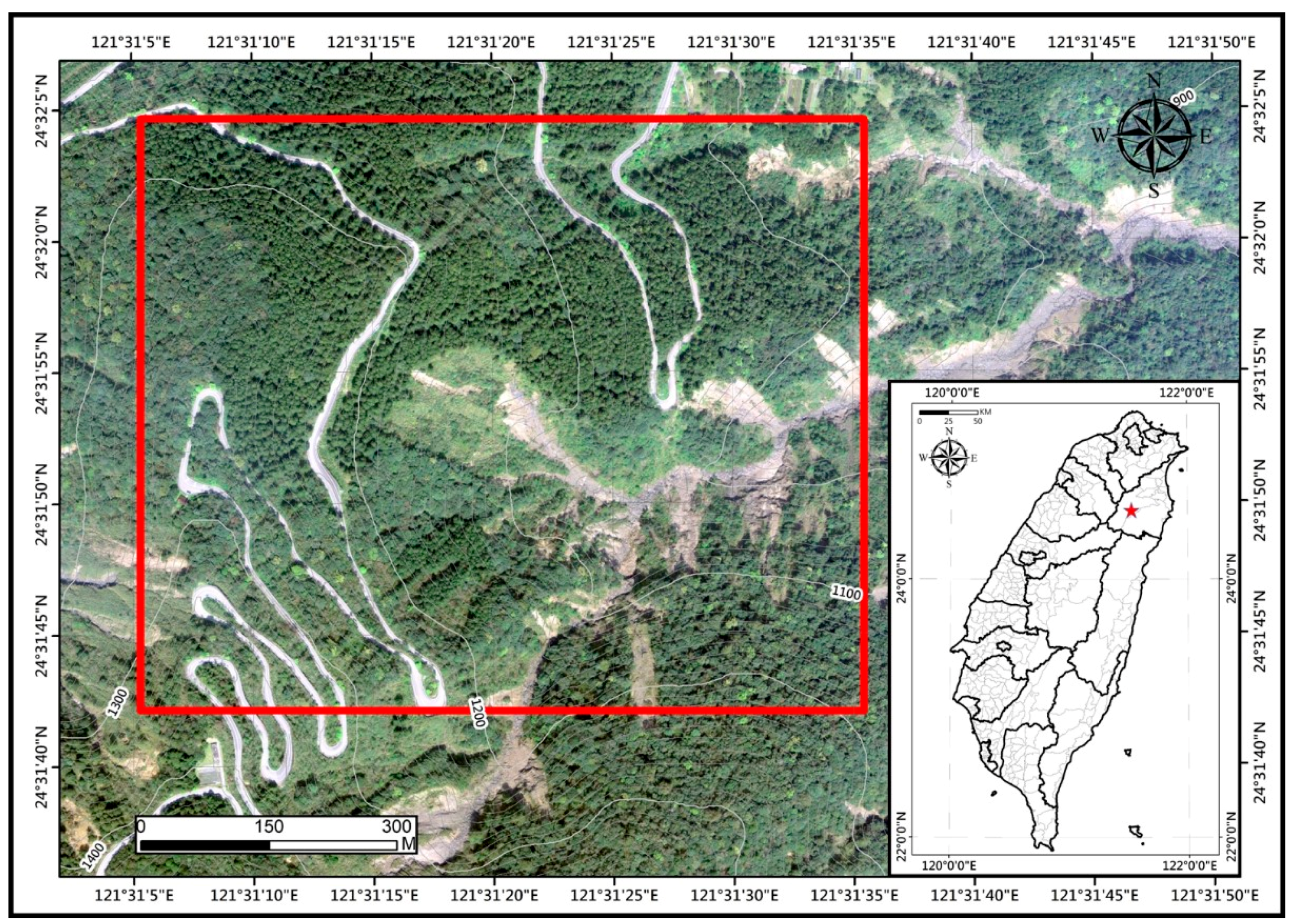
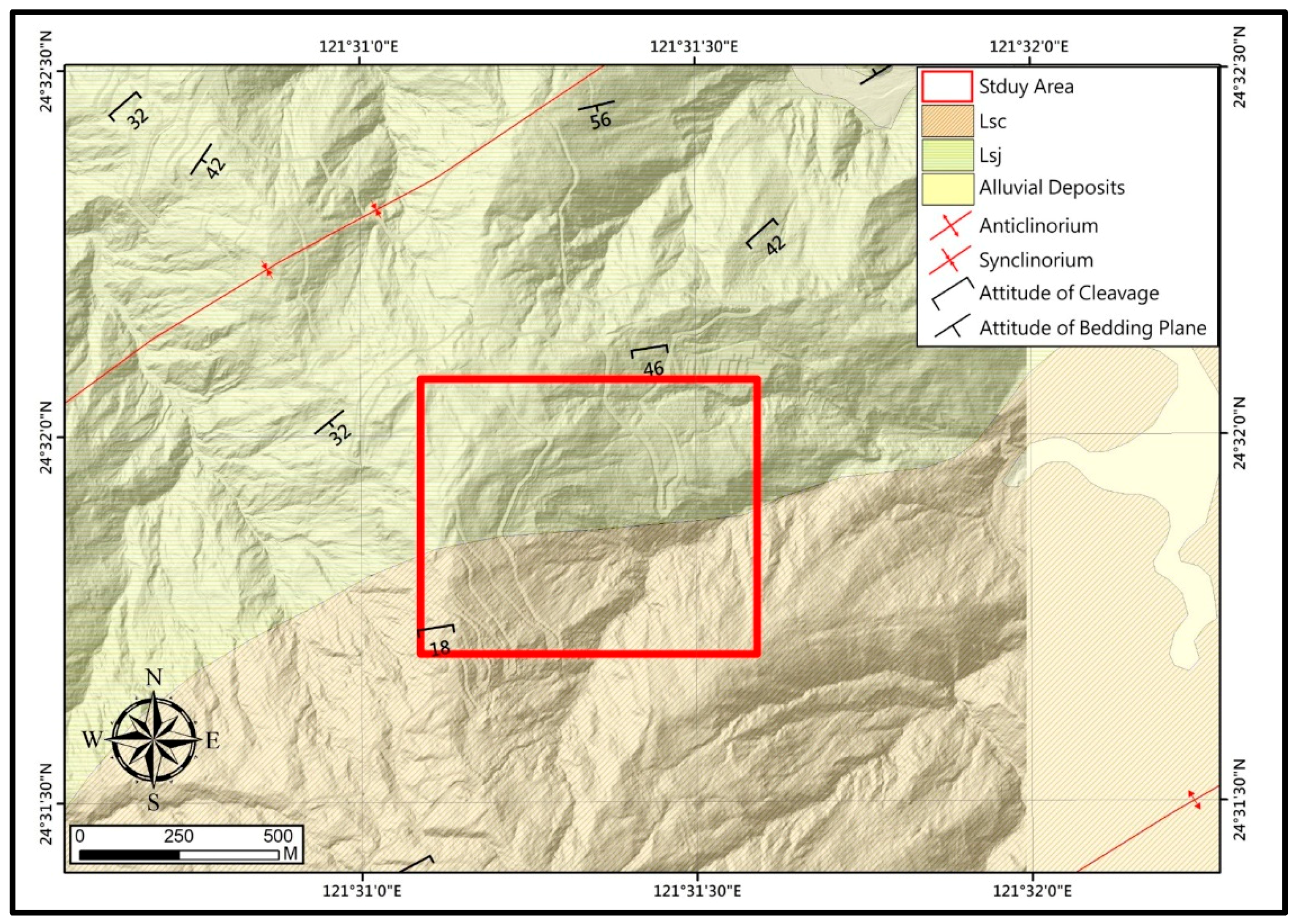
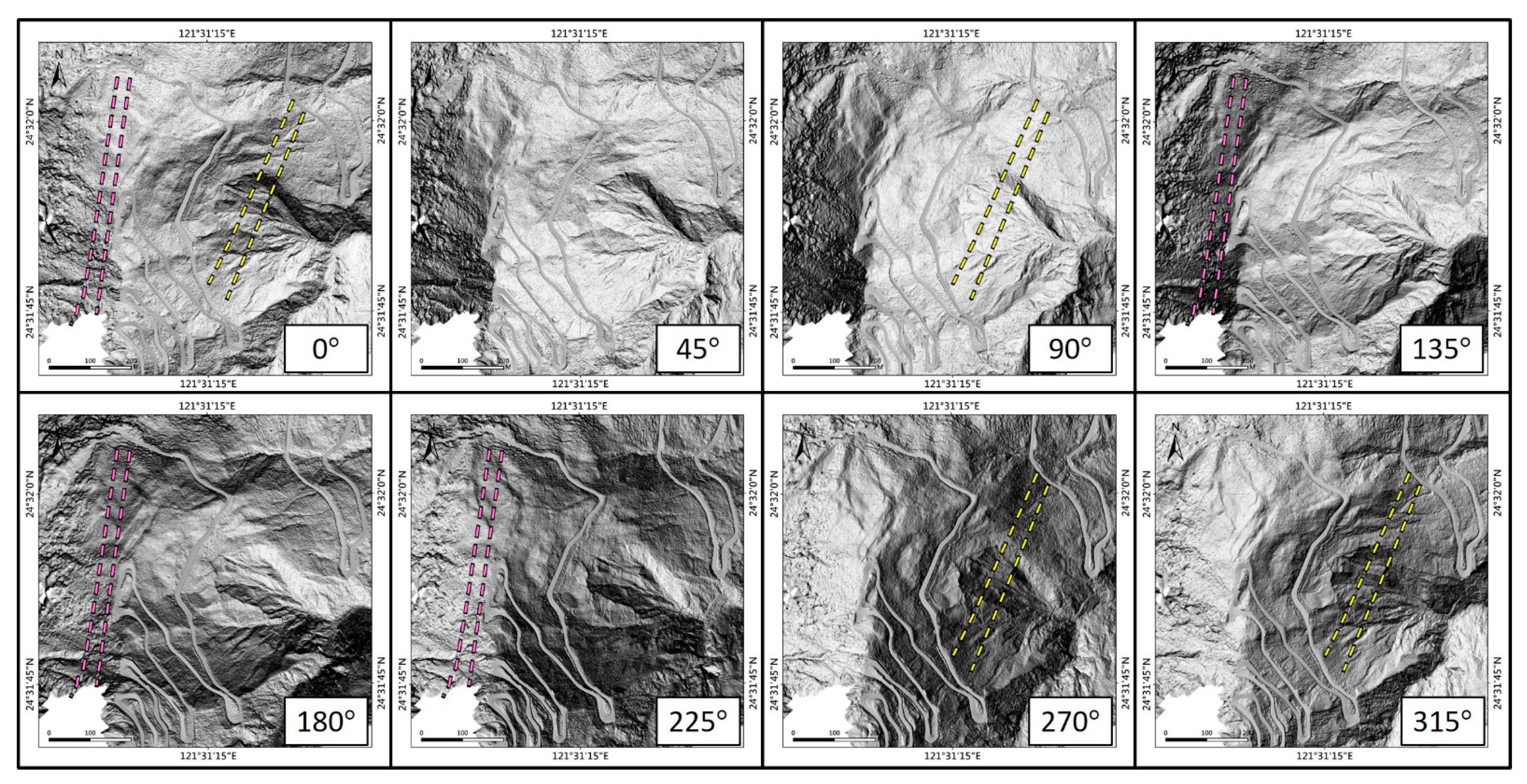

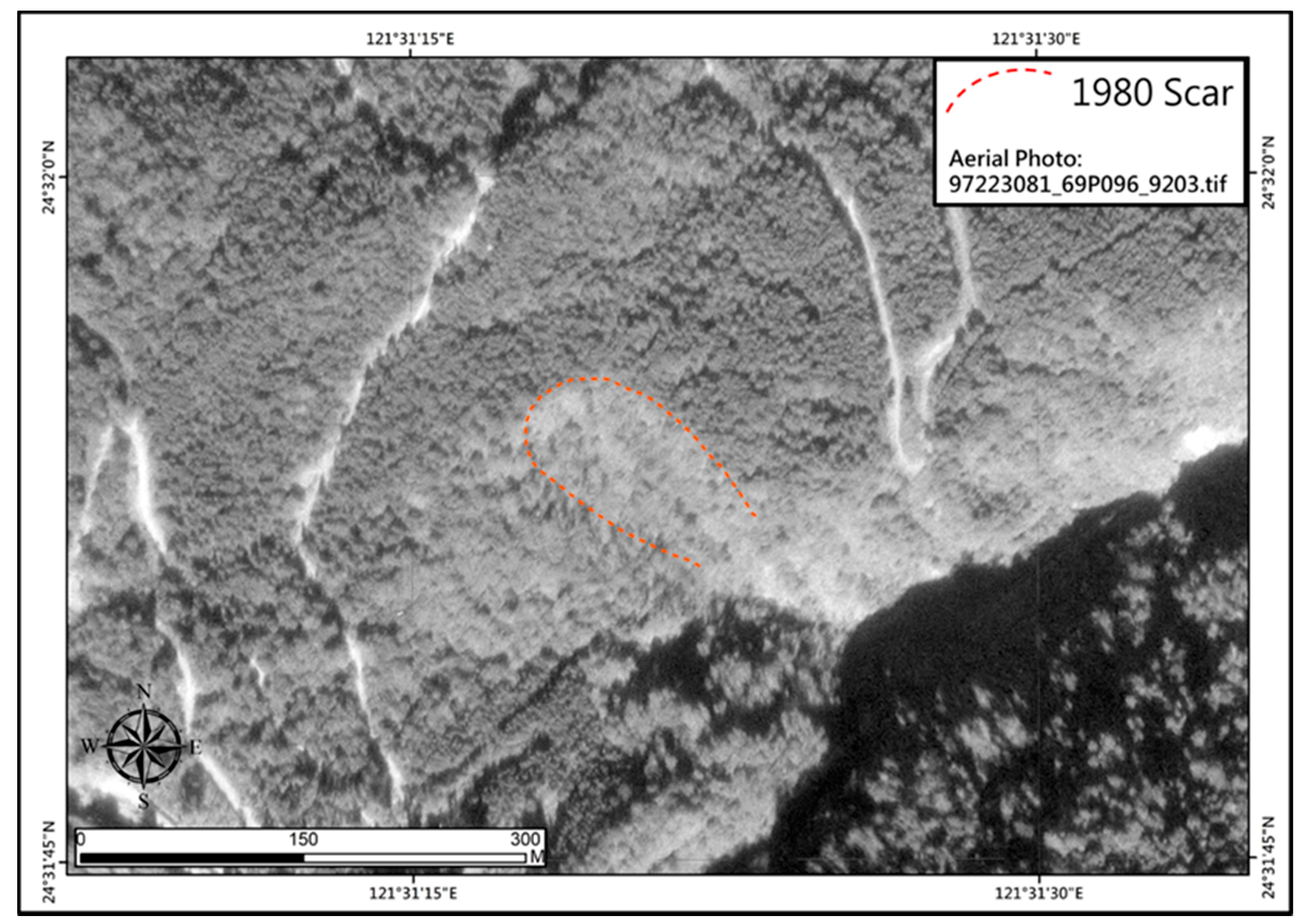

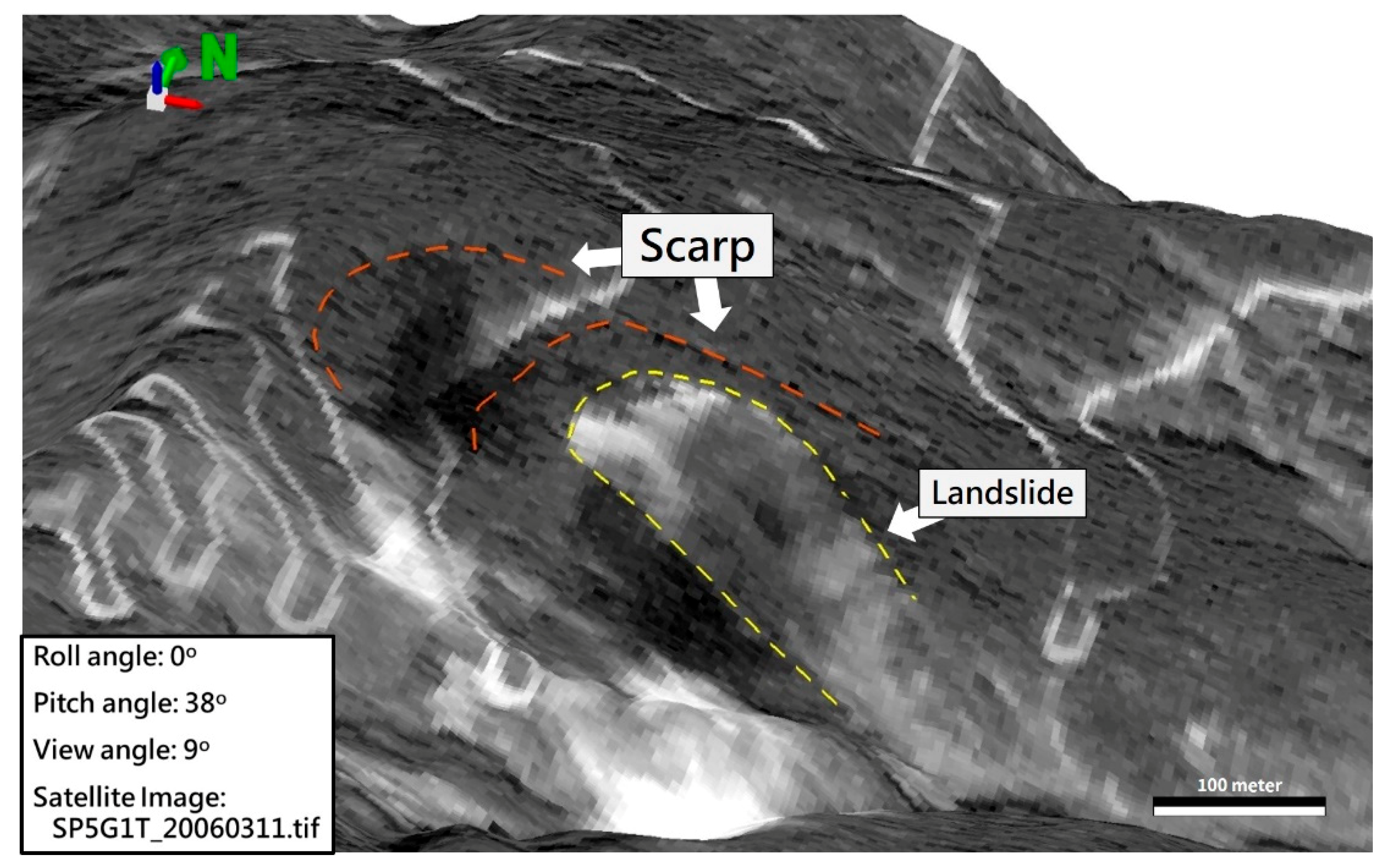
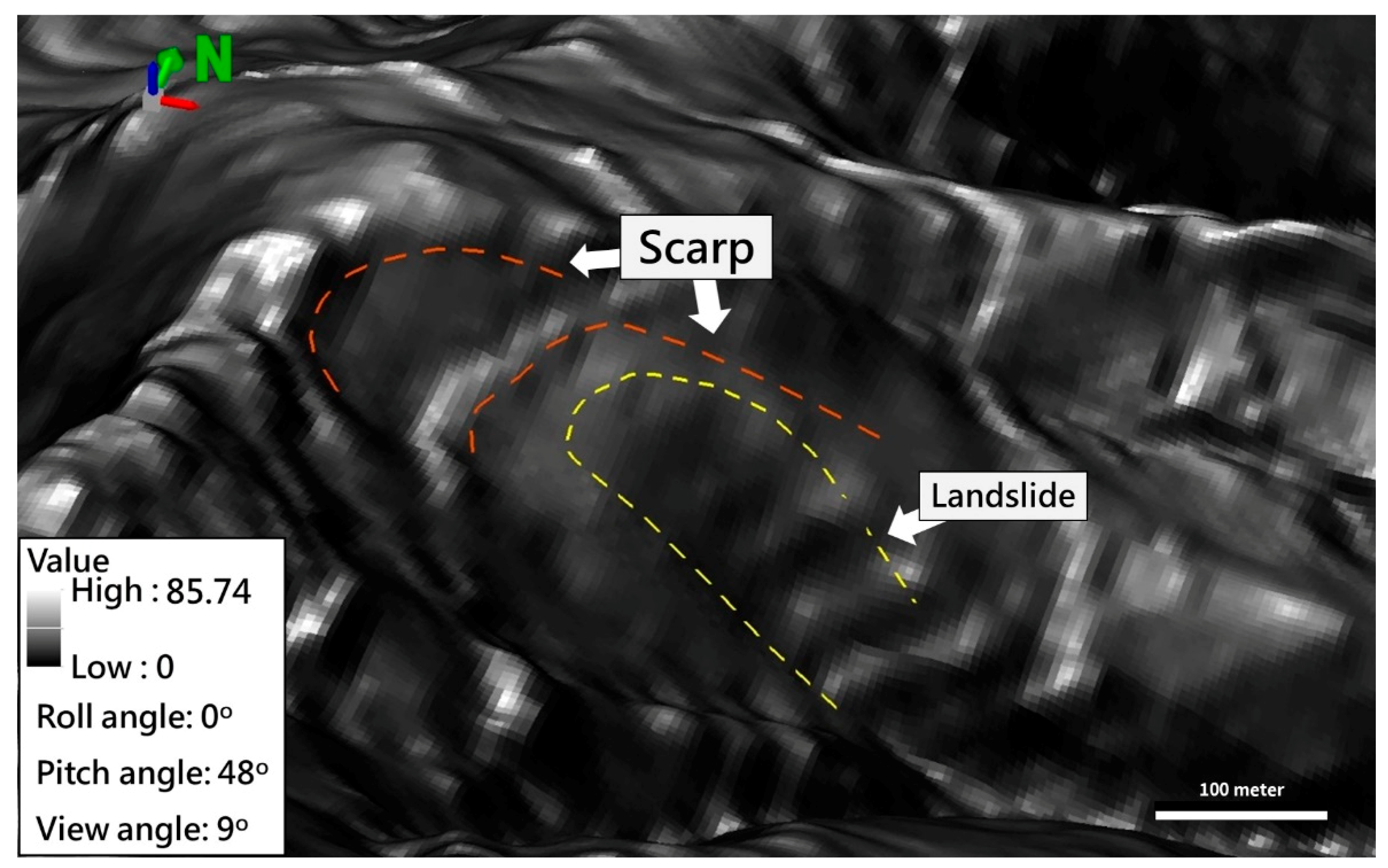
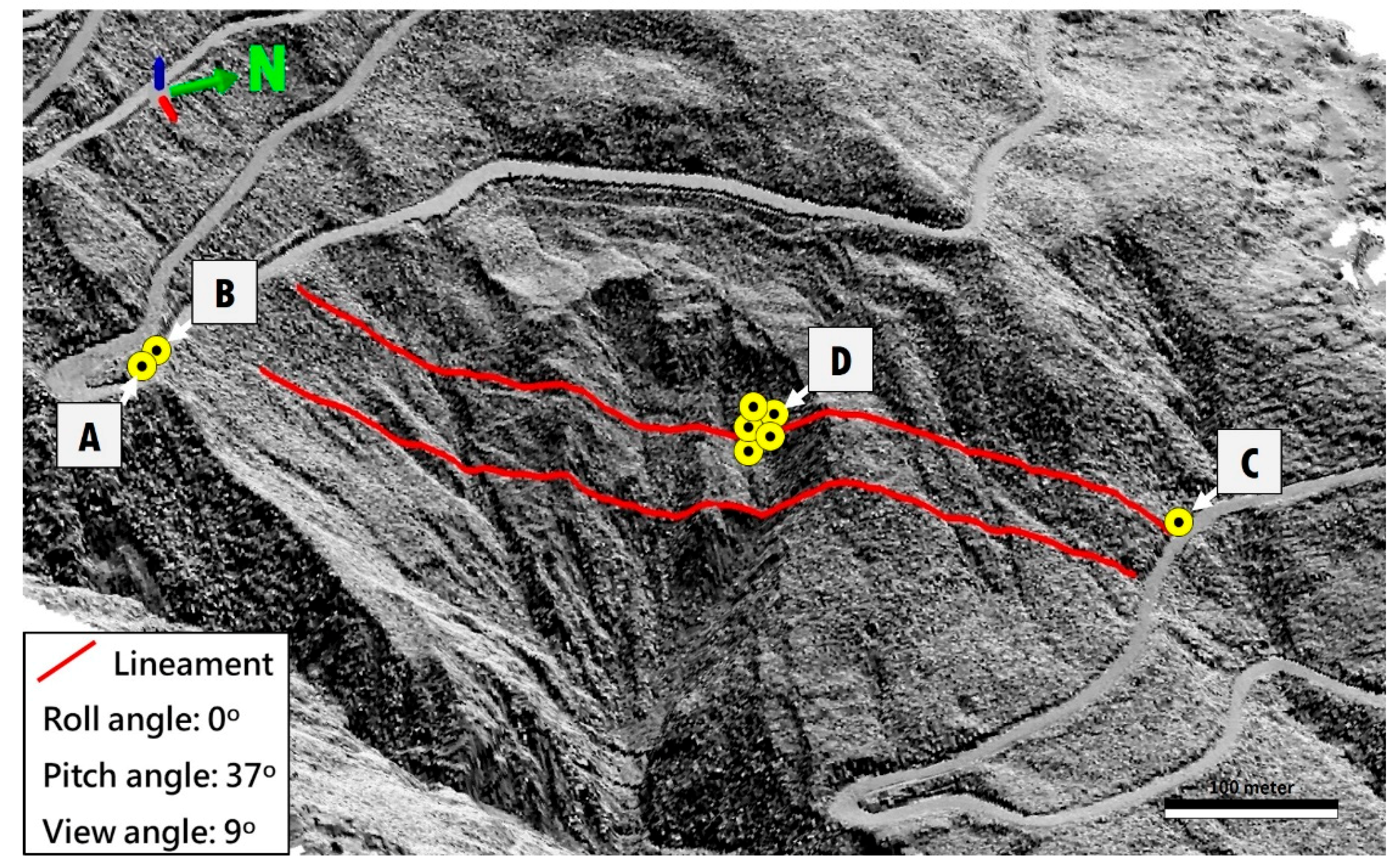

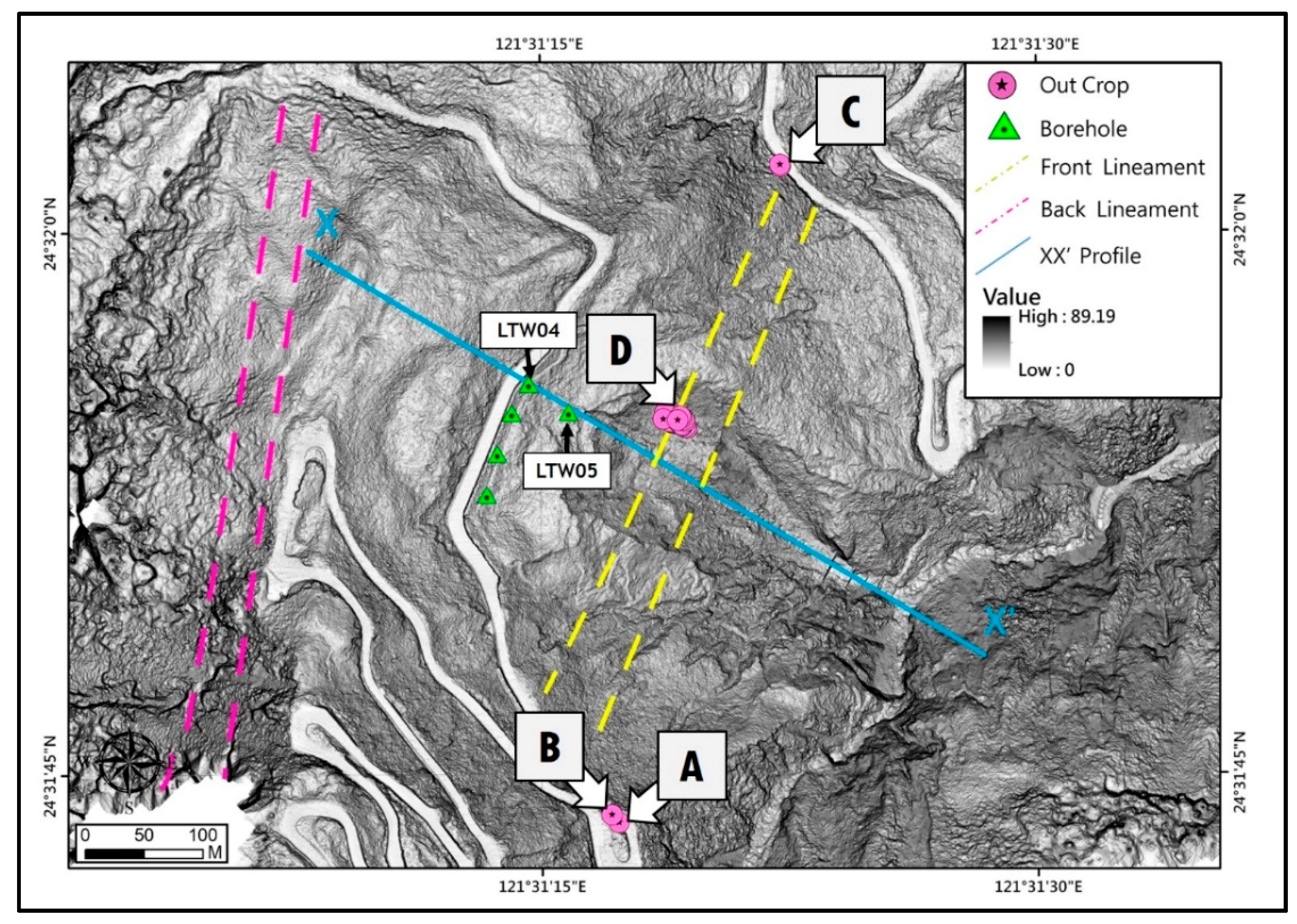
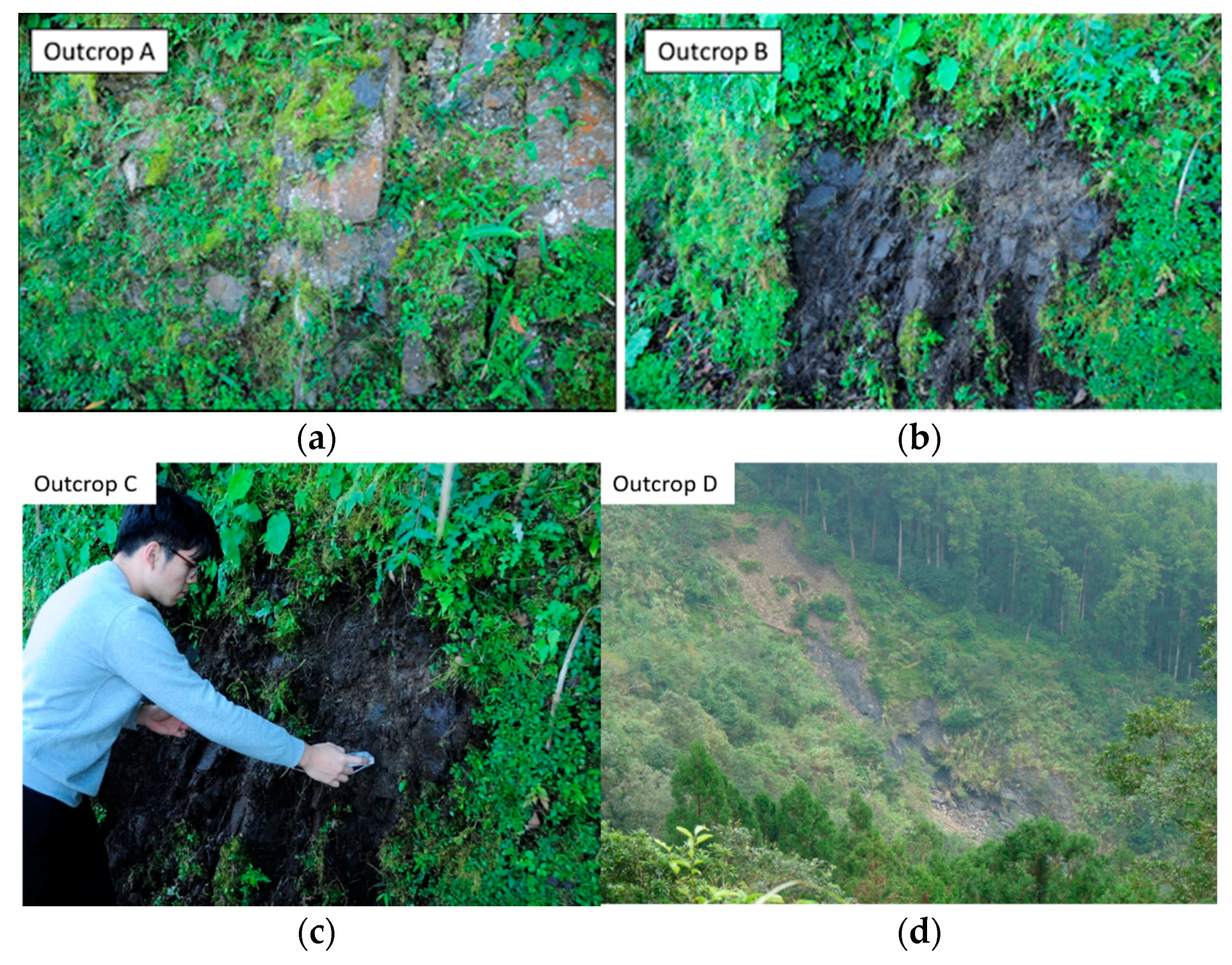
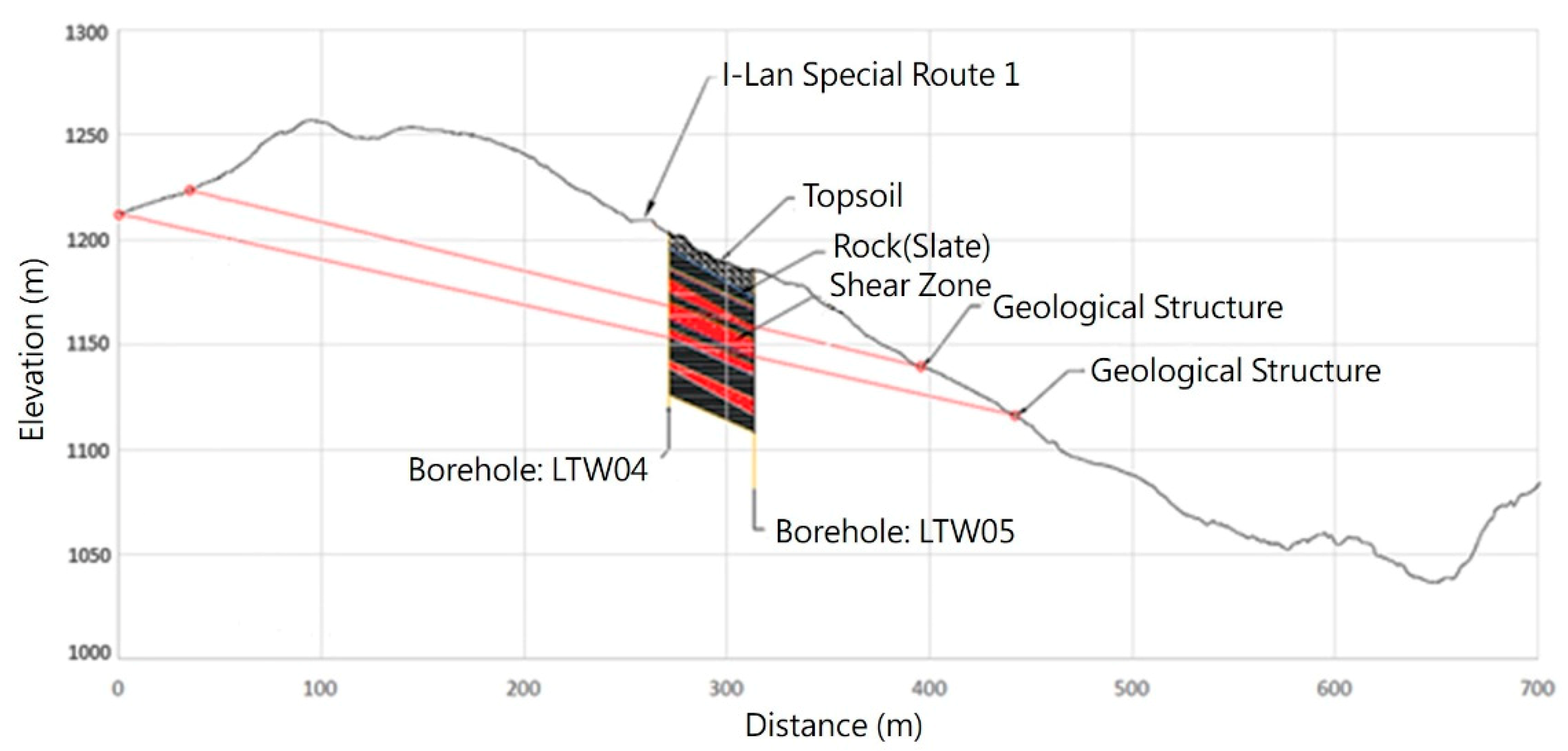
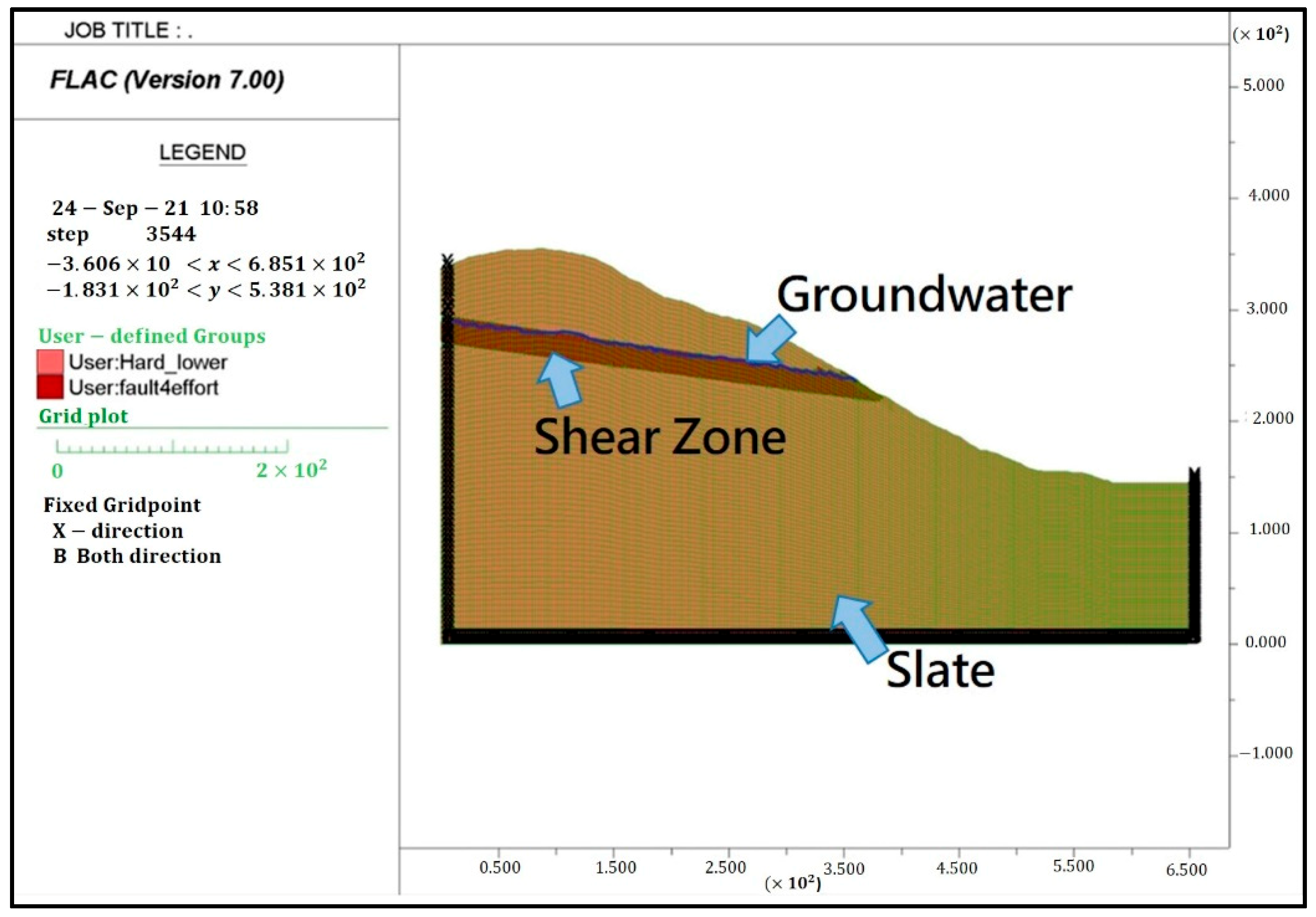


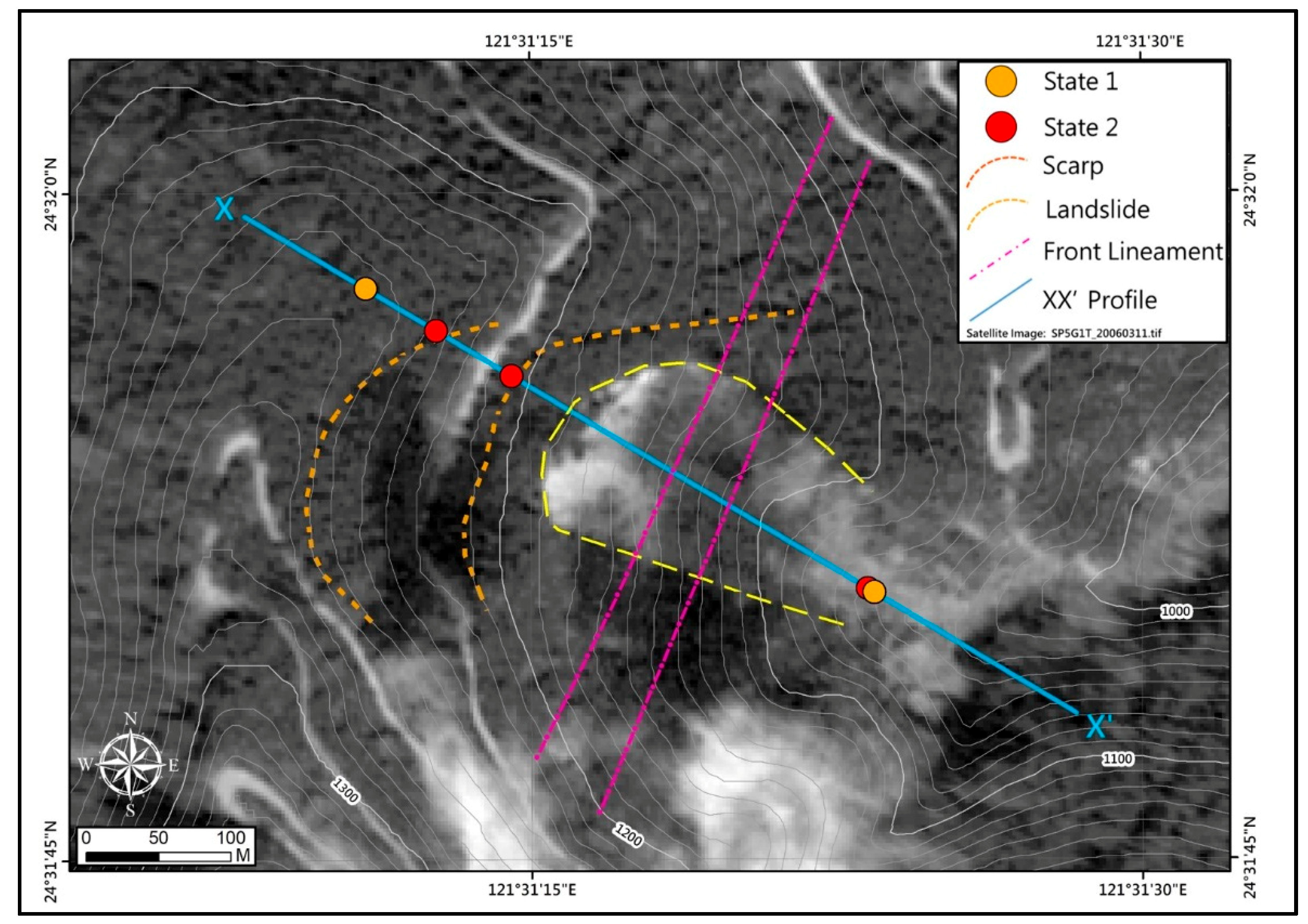

| Ground Layer | Mass Density (kg/m3) | Bulk Modulus (GPa) | Shear Modulus (GPa) | Cohesion (kPa) | Friction Angle (∘) |
|---|---|---|---|---|---|
| slate | 2700 | 2.92 | 1.35 | 180 | 35 |
| shear zone | 2700 | 1.59 | 0.73 | 100 | 25 |
Publisher’s Note: MDPI stays neutral with regard to jurisdictional claims in published maps and institutional affiliations. |
© 2021 by the authors. Licensee MDPI, Basel, Switzerland. This article is an open access article distributed under the terms and conditions of the Creative Commons Attribution (CC BY) license (https://creativecommons.org/licenses/by/4.0/).
Share and Cite
Lin, M.-L.; Chen, Y.-C.; Tseng, Y.-H.; Chang, K.-J.; Wang, K.-L. Investigation of Geological Structures Using UAV Lidar and Its Effects on the Failure Mechanism of Deep-Seated Landslide in Lantai Area, Taiwan. Appl. Sci. 2021, 11, 10052. https://doi.org/10.3390/app112110052
Lin M-L, Chen Y-C, Tseng Y-H, Chang K-J, Wang K-L. Investigation of Geological Structures Using UAV Lidar and Its Effects on the Failure Mechanism of Deep-Seated Landslide in Lantai Area, Taiwan. Applied Sciences. 2021; 11(21):10052. https://doi.org/10.3390/app112110052
Chicago/Turabian StyleLin, Meei-Ling, Yen-Cheng Chen, Yao-Hsien Tseng, Kuo-Jen Chang, and Kuo-Lung Wang. 2021. "Investigation of Geological Structures Using UAV Lidar and Its Effects on the Failure Mechanism of Deep-Seated Landslide in Lantai Area, Taiwan" Applied Sciences 11, no. 21: 10052. https://doi.org/10.3390/app112110052






